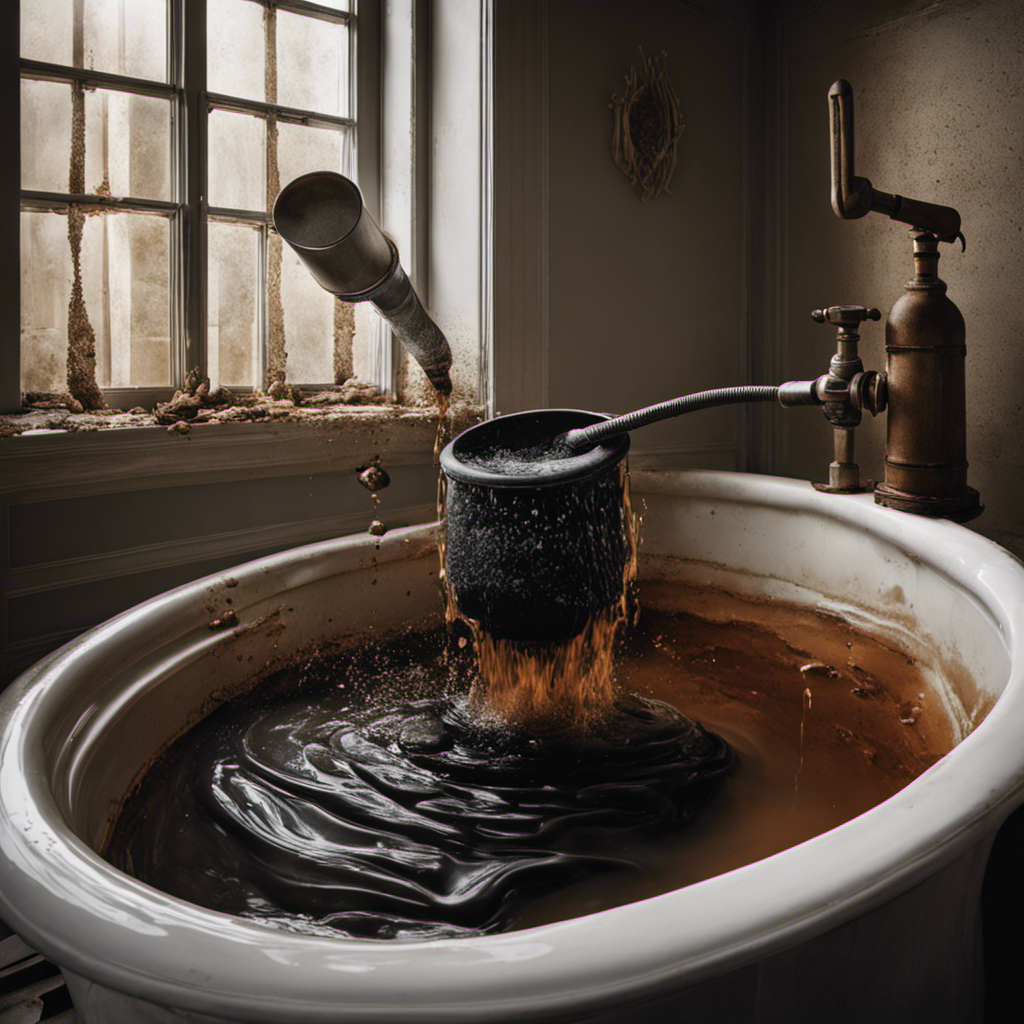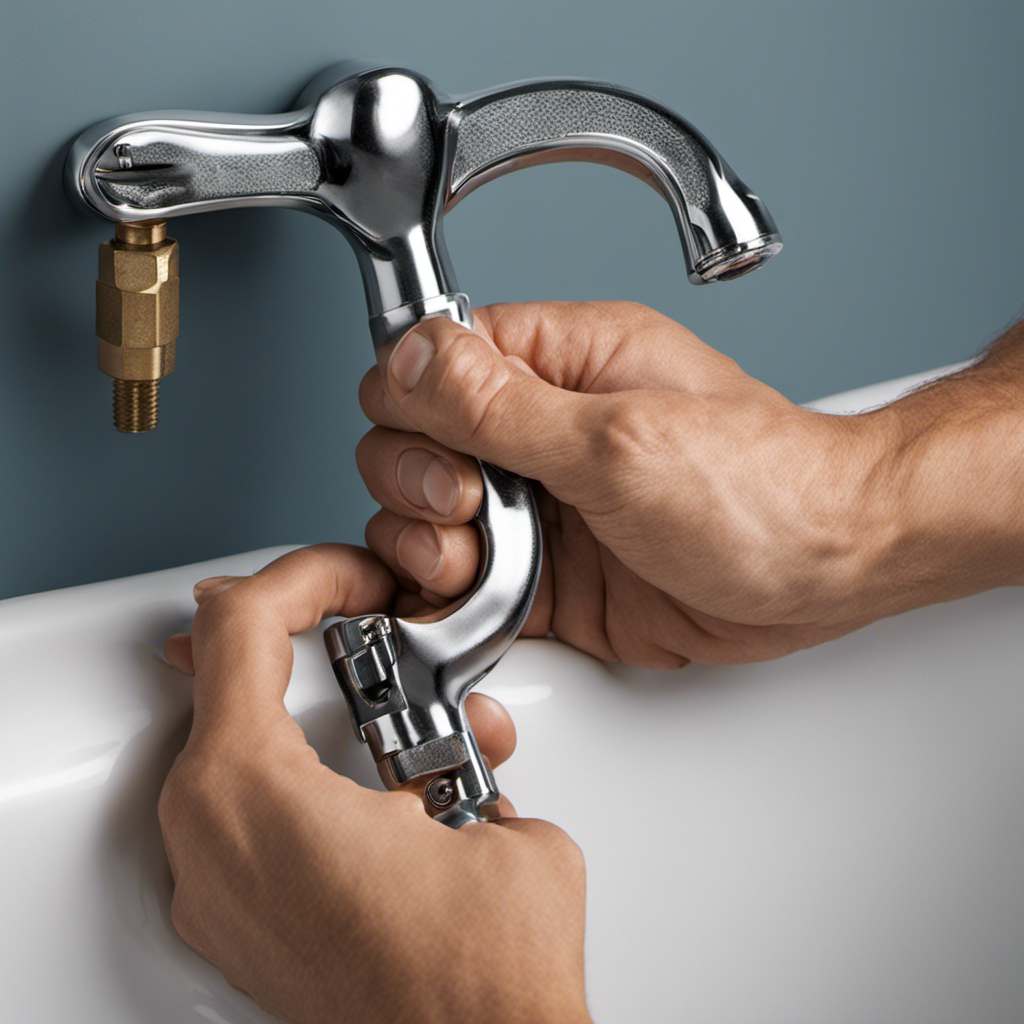Are you tired of dealing with a clogged bathtub drain that disrupts your daily routine? Well, you’re in luck! In this article, we will show you how to unclog your bathtub using simple DIY methods and effective solutions.
Get ready to say goodbye to those annoying clogs and hello to a smoothly flowing drain. So, grab your tools and materials, because it’s time to take matters into your own hands and unclog that bathtub once and for all!
Key Takeaways
- Hair and soap scum are the main causes of bathtub clogs.
- Essential tools for unclogging a bathtub include a plunger, wet rag, drain snake, baking soda and vinegar, and hot water.
- Simple DIY methods to clear a bathtub drain include using a plunger, hot water and dish soap, baking soda and vinegar, and a wire hanger.
- Using a plunger involves positioning it over the drain opening, ensuring it’s fully submerged, applying firm and consistent pressure, and trying hot water or a drain snake as alternatives if needed.
Understanding the Causes of Bathtub Clogs
To understand why your bathtub gets clogged, you should know that hair and soap scum are the most common culprits. These substances accumulate over time, creating blockages in your drain. Hair can easily get tangled and form clumps, while soap scum combines with minerals in the water to form a sticky residue. When these substances mix together, they create a solid mass that obstructs the flow of water.
While some clogs can be resolved with simple DIY methods, there are cases where professional bathtub unclogging services may be needed. These professionals have the expertise and tools to tackle more stubborn or complex clogs. Understanding the causes of common bathtub clog problems will help you determine the best approach to unclogging your bathtub.
Now, let’s move on to the essential tools and materials for unclogging a bathtub.
Essential Tools and Materials for Unclogging a Bathtub
You’ll need some essential tools and materials to successfully tackle the clog in your bathtub. Don’t worry, you can handle this yourself with some common household items.
First, grab a plunger. This simple tool can create the necessary pressure to dislodge the clog. Make sure to cover the overflow drain with a wet rag to maximize the suction.
If the plunger doesn’t work, try using a drain snake. This flexible tool can reach deep into the drain and snag the clog.
For stubborn clogs, a mixture of baking soda and vinegar can do the trick. Just pour them down the drain, let it fizz, and flush with hot water.
Simple DIY Methods to Clear a Bathtub Drain
Using common household items such as a plunger or a drain snake can help clear a clogged bathtub drain. If you find yourself dealing with a clog, don’t fret! There are several simple DIY methods you can try before resorting to professional plumbing assistance. Here are some effective home remedies to clear your bathtub drain:
-
Plunger: Using a plunger can create pressure that dislodges the clog.
-
Hot water and dish soap: Pouring hot water mixed with dish soap down the drain can help break up grease and debris.
-
Baking soda and vinegar: Sprinkling baking soda followed by vinegar and hot water can create a chemical reaction that loosens the clog.
-
Wire hanger: Straightening a wire hanger and using it to fish out the clog can be surprisingly effective.
-
Salt and baking soda: Mixing salt and baking soda with hot water can dissolve stubborn clogs.
Step-by-Step Guide to Using a Plunger for Bathtub Clogs
When dealing with a clogged bathtub drain, start by positioning the plunger over the drain opening. This step is crucial in order to create a proper seal and generate the necessary suction to dislodge the clog.
Make sure the plunger is fully submerged in water, as this will help increase the effectiveness of the plunging action. Apply firm and consistent pressure while plunging up and down for about 15-20 seconds.
If the plunger doesn’t work, another option is to try using hot water. Boil water and carefully pour it down the drain, allowing it to work its way through the clog.
If the clog persists, using a drain snake is another effective method. Insert the snake into the drain and rotate it clockwise to catch onto the clog. Slowly pull the snake out, bringing the clog with it.
Effective Chemical and Natural Solutions for Unclogging a Bathtub
To effectively address a bathtub clog, consider trying chemical or natural solutions that can help break down the obstruction. Here are some options to consider:
-
Chemical Solutions:
-
Liquid Drain Cleaners: These are readily available and can quickly dissolve hair and other debris.
-
Enzyme-based Cleaners: These are effective in breaking down organic matter and are environmentally friendly.
-
Caustic Soda: This powerful chemical can dissolve tough clogs but requires caution while handling.
-
Natural Solutions:
-
Baking Soda and Vinegar: This combination creates a foaming reaction that can dislodge clogs.
-
Hot Water and Salt: A mixture of hot water and salt can help dissolve grease and soap scum.
When choosing between chemical and natural solutions, consider the pros and cons. Chemical solutions are often more potent and can tackle stubborn clogs, but they may contain harsh chemicals. Natural solutions are safer for the environment but may require more time and repeated applications. Choose the option that best suits your needs and preferences.
Frequently Asked Questions
How Much Does It Cost to Hire a Professional Plumber to Unclog a Bathtub?
To unclog your bathtub, you can hire a professional plumber. The cost varies depending on factors like location and severity of the clog. However, before spending money, consider cost comparison and try DIY methods.
Can I Use a Wire Hanger to Unclog My Bathtub Drain?
Using a wire hanger to unclog your bathtub drain is a common DIY method. However, there are alternative techniques for clearing the blockage effectively. Regular bathtub drain maintenance can prevent clogs altogether.
Is It Safe to Use Bleach as a Chemical Solution for Unclogging a Bathtub?
Using bleach as a chemical solution for unclogging a bathtub may be effective, but it can have potential risks. It’s recommended to consider using vinegar instead, which can be a safer option.
Are There Any Natural Remedies for Preventing Bathtub Clogs?
To prevent bathtub clogs, try these natural remedies: 1) Mix baking soda and vinegar, causing a fizzy reaction that breaks down debris. 2) Use a drain strainer to catch hair and other particles. Eco-friendly solutions make a difference.
How Long Does It Usually Take to Unclog a Bathtub Using a Plunger?
To effectively use a plunger to unclog a bathtub, start by creating a seal around the drain. Push and pull the plunger vigorously to dislodge the clog. If it doesn’t work, try troubleshooting common issues like air leaks or insufficient water.
Conclusion
Congratulations on successfully unclogging your bathtub! By following the simple DIY methods and using the essential tools and materials, you were able to tackle the clog head-on.
Remember, prevention is key, so make sure to clean your drains regularly to avoid future issues. Now you can enjoy a relaxing bath without any worries.
So sit back, relax, and let the stress wash away down the drain with your clog. You’ve officially become the superhero of unclogging!










